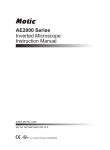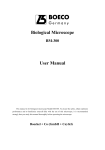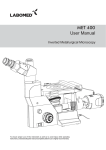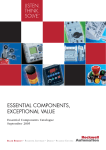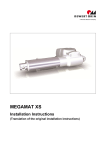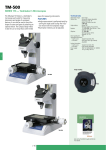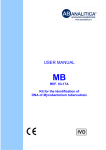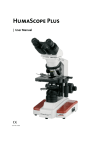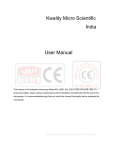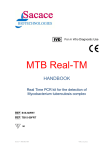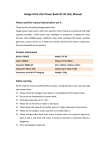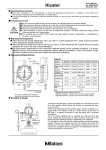Download Novel XSZ-107T Biological Microscope Manual
Transcript
Biological Microscope Model XSZ-107T With an Epi-Fluorescence (YX-2) attachment USER AND OPERATIONAL MANUAL This manual is for the biological microscope XSZ-107T. To ensure the safety and optimum performance of this unit, please ensure a thorough familiarization with this manual so as to become comfortable with the use of this unit. 1|Page Novel XSZ-107T with YX-2 Epi- Fluorescence Attachment Contents 1. Application ................................................................................................................................................................ 3 2. Safety Note............................................................................................................................................................ 3 3. Maintenance and care .......................................................................................................................................... 4 4. Components of the microscope ................................................................................................................................ 5 5. Assembly ................................................................................................................................................................... 6 6. Assembly Procedure ......................................................................................................................................... 7 6.1 Installing the epi-florescence unit................................................................................................................. 7 6.2 Installing the binocular head............................................................................................................................... 7 6.3 Installing the Eyepieces ................................................................................................................................. 8 6.4 Installing the objectives ................................................................................................................................ 8 7. Connecting the power cords ................................................................................................................................. 9 8. Adjustment Set Diagram ..................................................................................................................................... 10 .................................................................................................................................................................................... 11 9. Adjustment and Operation for brightfield microscopy ...................................................................................... 12 9.1 10. Brightness Adjustment ................................................................................................................................ 12 Focusing on the specimen.............................................................................................................................. 13 10.1 Focus on the specimen ............................................................................................................................... 13 10.2 Condenser adjustment ................................................................................................................................ 13 10.4 Adjusting the interpupillary distance .......................................................................................................... 14 10.5 Adjusting the dioptre .................................................................................................................................. 14 10.6 Adjusting the tension adjustment collar ..................................................................................................... 14 11. Using the Epi-Florescence attachment for specimen observation ................................................................. 14 11.1 13. Preparation ................................................................................................................................................. 15 Technical Specifications ...................................................................................................................................... 16 13.1 Main specifications of the microscope XSZ-107T ....................................................................................... 16 13.2 Main specifications of the epi-florescence attachment YX-2 ..................................................................... 16 12.1 Fluorescent Filter Combinations ................................................................................................................. 17 2|Page 1. Application The XSZ-107 series microscope is a multi-purpose bio-microscope that has been specifically designed for clinical and chemical examination. The application and use of this series of microscopes is very diverse and extends to professional research, teaching demonstration, use in medical and health establishments, laboratories, technology, research and tertiary education facility. Its accessories make the instrument capable of accomplishing a very diverse and wide range of practical use. The XSZ-107 can be adapted in many ways including phase contrast, florescence, photography, camera depiction, television and computer based image processing. The XSZ-107 can also be used for routine work in the fields of biology, bacteriology, histology, cytology, haematology and pharmacology easily (to name a few). The microscope unit is used in conjunction with the epi-fluorescent attachment which has been designed for use with and including our biological microscopes such as the Novel N-400M, Novel N320M and the Novel XSZ-107CCD. 2. Safety Note a. Carefully open the box, avoid the accessories dropping to the ground and being damaged. The epi-fluorescent attachment is a precision instrument. b. Please ensure that the entire unit is kept out of direct sunlight, high temperatures, humid or dusty environments. c. Make certain that the power cords are installed correctly and that all other components are connected firmly. d. Do not open any of the lamp housings while they are turned on or for at least 10 minutes after they have been turned off. These parts are extremely hot and can cause burns if touched. e. Always be sure to ground (earth) the equipment. f. Verify that the voltage and the frequency of the AC mains outlet match the setting of the voltage switch and the frequency switch on the rear of the power supply units. g. Always use the power cord provided by NOVEL and make sure that the main switch is moved to “O” (OFF) before connecting the power cord plug to the wall outlet. h. To prevent any hazard, always turn the main switch on the power supply unit to “O” (OFF), unplug the power cord plug from the mains outlet before replacing any bulb or the fuse, and wait for at least 10 minutes before replacing the bulb. i. To prevent obstruction of the air flow, it is important to make sure to leave enough space around and above the lamp housing of the microscope as well as epi-florescence attachment. 3|Page Safety Symbols The following symbols are found on the system. Study the meaning of the symbols and always use the equipment in the safest possible manner. Symbol Explanation Indicates that the surface becomes hot, and should not be touched with bare hands。 Indicates that the high voltage (upper 1KV) inside, improper handing could result in an electric shock to the use. Before use, carefully read the user manual .Improper handing could result in personal injury to the user and/or damage to the equipment. Indicates that the main switch is ON. Indicates that the main switch is OFF. ● This manual is written for the XSZ-107T with an epi-fluorescent attachment YX-2 and before equipping it with any other ordinary microscope, be sure to learn how to use the microscope. 3. Maintenance and care 3.1 All the lenses have been adjusted properly, please do not dismount any lenses by oneself as this will render any warranties / guarantees void. 3.2 The nosepiece and coarse / fine focus parts are very delicate and should under no circumstances be dismantled by anyone who has not received correct training on how to repair any faults that may occur. 3.3 Keep the units clean at all times. Do not place any hazardous chemicals near the units as the lenses will get damaged and shall not be replaced under warranty. 3.4 If, under certain circumstances, certain contaminants end up on the lenses (i.e fingerprints, oil smudges) one can clean these off with a soft cloth, tissue paper or gauze which has been slightly immersed in pure alcohol or ether. Note that the alcohol or ether is extremely flammable; please take extra precaution when using this method by keeping the cleaning solution and cloth or material away from potential sources of electrical spark or fire. 3.5 Do not attempt to use any organic (live) solvents to clean the microscope or epi-florescence unit and other glass components. To clean the microscope and exterior of the epi-florescence unit, use of a lint-free, soft cloth slightly moistened with a diluted neutral detergent. 3.6 While in use, if at any moment, some liquid of any form splashes onto the microscope, immediately switch the unit off and remove any liquid that may still be visible. 3.7 Do not dis-assemble any parts of the microscope or the epi-florescence unit as this will compromise the function or reduce the overall performance of the unit. 3.8 Always place the unit in a cool, dry level surfaced location. When not in use, keep the unit covered with the provided dust cover and make sure that the microscope as well as attached epi-florescence unit has sufficiently cooled before storing away. 4|Page 4. Components of the microscope 5|Page 5. Assembly Assembly Diagram The Following figure shows the completed installation of the components: The corresponding figures show the assembly steps. • Before installation, ensure the unit is clean as well as every component, do not store unpacked units in a room which has high temperatures, high humidity or a dusty environment. 6|Page 6. Assembly Procedure 6.1 Installing the epi-florescence unit Place the epi-florescence unit on top of the microscope body and tighten the holding screw firmly to hold the unit in place 6.2 Installing the binocular head Insert the binocular viewing head into the epi-florescence unit and then mount it onto the microscope and ensure it is in the correct position and bolt it down to ensure no movement 7|Page 6.3 Installing the Eyepieces Insert the eyepiece into the eyepiece tube until they are level with the eyepiece tubes as shown 6.4 • • Installing the objectives Adjust the coarse focus knob until the support device of the mechanical stage reaches its lowest limit position. Screw the lowest magnification objective into the nosepiece from the left or the right side and then revolve the nosepiece clockwise and place one objective per open socket until all the objectives are installed. Clean the objectives regularly as the lenses are susceptible to dust. When operating the microscope, always use the 10x (yellow band) objective to find the specimen first, then rotate the nosepiece to magnify the specimen. When rotating the nosepiece, always make sure one hears the “click” sound to know the objective is in place and ready for observation. 8|Page 7. Connecting the power cords • The cables and power cords are vulnerable when bent or twisted; never subject the power cords to excessive force. • Set the main switches to the off “0” position before connecting any of the power cords. • Insert the power cord jack into the power of the microscope unit Safely. 7.1 Charging of Battery and switching on • The “I“ position power is ON. You can use the unit plugged in, and the battery will charge while in use. • The “II” position indicator renders the power as OFF. You cannot use incident illumination as the LED will be off. If plugged in the internal battery unit will automatically charge. • “0” power is OFF. There will be no charging of the battery and no illumination of the LED even if the unit is plugged in to the AC mains power supply. Once charging of the internal battery has commenced, a red power indicator shall be observed. If the internal battery has reached its full charge capacity, the red light will extinguish and a green light will appear. Once in use, if one disconnects from the main AC power – the internal battery will hold enough current to illuminate the LED for up to 8 hours without requiring a re-charge. If the battery is completely drained, the microscope can be used, plugged into the wall outlet. It is used on the same application as a laptop. • Red Light - When charging the microscope, if the LED power indicator light is red, the battery is not fully charged. • Green Light - When the LED power indicator light green, the battery is fully charged. • If the unit has been stored for more than a week without any AC power, it is advisable to charge the unit up over a minimum of 18 hours before normal operation. Insert the power cord into the epi- fluorescence power module safely - Or Insert the power cord into the battery backup epi-florescence power module safely. If the battery backup epi-florescence power module has been stored for more than a week without any AC power, it is advisable to charge the unit up over a minimum of 18 hours before normal operation. 9|Page 8. Adjustment Set Diagram 10 | P a g e 11 | P a g e 9. Adjustment and Operation for brightfield microscopy 9.1 Brightness Adjustment 9.1.1 Connect the power cord and set the main power switch on to the (on) position “I” . 9.1.2 Turning the brightness adjustment knob, increase the brightness of the illumination set to the users’ satisfaction. Ensure the epi-florescence attachment is set to the “0” setting, or in the middle setting 9.1.3 9.1.4 Place the specimen slide on the stage in the centre and use the stage swing arm to secure the slide in place. 9.1.5 Turn the vertical and horizontal adjustment knobs of the mechanical ruler to move the specimen to the required position. • Be careful when changing objectives to another magnification. If you are finished working with a magnification with a short working distance (i.e. 40x / 100x OIL) and want to change to another one, be aware that you may touch the specimen. 12 | P a g e 10. Focusing on the specimen 10.1 Focus on the specimen Focus on the specimen using the 10x objective. To avoid touching the specimen during focusing, you should raise the stage to its maximum height adjustment and observe whether it is close to the objective at first, then using the fine focus slowly lower the stage while observing through the eyepieces until a clear crisp image is seen. 10.2 Condenser adjustment Turn the condenser focusing knob to move the condenser up or down. Raise the condenser when using the high magnification objectives, and conversely lower it when using a lower magnification objective. • The condenser and objective are coaxial. The condenser has been adjusted and pre-set before leaving the factory, and the maximum height has been pre-set, so the enduser has no need to adjust it oneself. 10.3 Aperture Iris Diaphragm Adjustment Turn the aperture iris diaphragm lever to adjust the aperture iris diaphragm. • The aperture iris diaphragm is designed for the adjustment of the numerical aperture, not for brightness. • Generally, setting the aperture iris diaphragm to 70 % – 80 % of the numerical aperture (N.A.) of the objective in use will provide an image with good contrast. If one chooses to observe the image of the aperture iris diaphragm, one can remove one eyepiece and look down the eyepiece tube. One will observe a dark ring encroaching from the sides of the tube at the end of the viewable range. 13 | P a g e 10.4 Adjusting the interpupillary distance The interpupillary distance range of the microscope head is 55mm ~ 75mm. Push the eyepieces together and then while looking through the eyepieces, move the distance apart until the left and right fields of view coincide correctly. 10.5 Adjusting the dioptre Turn the eyepiece to adjust the dioptre while looking through it. • The diopter range of the eyepiece is approximately 5 diopter. The number aligned to the line on the viewing head is the dioptre in use. 10.6 Adjusting the tension adjustment collar Turn the tension adjustment collar with your fingers. When the collar is turned in the direction of the arrow in the figure displayed tension of the coarse adjustment knob increases. Turning the collar in the opposite direction as indicated decreases the tension. If the stage descends on its own weight of the specimen goes out of focus for no reason even when brought into focus using the fine focus adjustment knob – it means that the tension collar needs to be adjustment with more tension. Turn the tension ring in the direction indicated and the specimen shall remain in focus. 11. Using the Epi-Florescence attachment for specimen observation G-excitation filter G-cutoff filter Protection filter B-excitation filter B-cutoff filter 14 | P a g e 11.1 Preparation 11.1.1 Verify that the plug from the AC mains outlet is connected firmly into the connector of the power supply units. 11.1.2 Make sure the power cord is connected firmly. 11.1.3 When transmitted light observation is required, pull out the filter system and make the hole in the light path. 11.1.4 Be sure to use immersion oil when using fluorescent OIL objectives. 11.1.5 When it is required to interrupt observation for a short period, use the shield in the assistant excitation filter part. 11.1.6 Precautions on the specimen colour fading: 11.1.6.1 The system employs high-intensity excitation light to enable bight observation of dark fluorescent specimens. As a result, if high-power objectives are used frequently colour fading of the specimen occurs early, degrading the view (contrast) of fluorescent images. So it is effective to use the shutter frequently to avoid illuminating the specimen for a longer period than required. 11.1.6.2 Colour fading of the specimen can also be delayed using commercially available colour fading preventing agent (DABCO, etc). The use of colour fading preventing agent is recommended when you perform high-magnification observation frequently. ★ Note that colour fading prevention agent cannot be used with certain specimens. 12. Switching on Electrical Source of the LED driven epi-florescence unit • Set the main switch of the power supply unit to “1” (ON). The LED diode will be at full capacity immediately after ignition. • • To avoid shortening the burner life, do not turn the burner off and on repeatedly The LED Diode is at full temperature and efficiency after 30 seconds and the aluminium holder can warm considerably after about 10 minutes, it is advisable to leave the unit off for approximately 10 minutes before moving the unit to allow sufficient cooling to occur. 15 | P a g e 13. Technical Specifications 13.1 Main specifications of the microscope XSZ-107T Optical System 160mm path length Viewing head Siedentopf Binocular Head, inclined at 30° Interpupillary distance of 55 – 75mm Eyepiece Wide Field Eyepiece WF 10x / 18 Magnification 10x Focal length 25mm Field of View 18mm Nosepiece Quadruple nosepiece Focusing Coaxial Coarse and Fine Focus adjustment, moving range 20mm, Fine Focus Division 0.002mm Condenser ABBE condenser, NA = 1.25 with iris diaphragm Stage Double layer mechanical stage 140mm x 140mm. Moving range of 75mm x 50mm Illumination 3.6V 1w Ultra-Bright 350mA LED illumination Power Supply AC Input 200V or 110V DC power output 5.5V Battery assistance for power outages 3.6V 3800mAh (8 Hours operation) 13.2 Epi-Fluorescent Illumination Illumination Protection Barrier Power Supply Objective Main specifications of the epi-florescence attachment YX-2 Fluorescent Filter Specifications B Exciting Light Filter System G Exciting Light Filter System 3w Ultra Bright CREE-XML LED Diode Barrier to Resist the Ultraviolet Light Power supplier AC Input 220V/110V (Interchangeable) 3.6v 1000mA constant current DC output Power supplier AC Input 220V/110V (Interchangeable) 3.6v 1000mA constant current DC output with battery back-up 10000 mAh 160mm Fluorescence Free Objective 10X 160mm Fluorescence Free Objective 20X 160mm Fluorescence Free Objective 40X 160mm Fluorescence Free Objective 100X OIL Immersion Oil Vertical Illumination Fluorescence Free Oil ● Achromatic Optics System ● Filtering System ● Observation Methods • Fluorescence • Transmitted Light (Brightfield) Lamp Housing ● Aluminium Lamp Housing ● CREE XM-L 3w LED Illuminator 16 | P a g e Operating Environment ●Indoor Use ●Altitude: Max. 2000m ●Ambient Temperature: 5℃ to 40℃ (41℉ to 104℉) ●Maximum RelaPve Humidity 80% for Temperature Up to 31℃ (88℉) Decreasing linearly through 70% at 34℃ (93℉), 60 % at 37℃ (99℉) to 50% relative humidity at 40℃ (104℉) ● Main supply voltage fluctuations not to exceed ±10% of the nominal voltage ● Pollution Degree 2 (in accordance with IEC 664) ● Installation/ Over voltage Category Ⅱ(in accordance with IEC 664) 12.1 Fluorescent Filter Combinations excitation applications U ·Auto-fluorescence observation ·DAPI:DNA ·Hoechest 332528, 33342:Chromosome V ·Catecholamines ·5-hydroxy tryptamine ·Tetracycline:Skeleton,Teeth B ·FITC:Fluorescent antibody method ·Acidine orange:DNA, RNA ·Auramine:Tubercle bacillus ·EGFP,S65T,RSGFP G ·Rhodamine,TRITC:Fluorescent antibody method ·Propidium iodide:DNA。 ·RFP 17 | P a g e



















